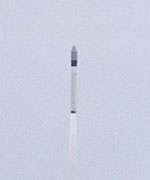
Image credit: Eurockot
A Russian Rockot booster successfully launched nine microsatellites into different orbits on Monday. The Rockot, a converted RS-18 intercontinental ballistic missile, lifted off from the Plesetsk cosmodrome in Northern Russia and reached orbit 10 minutes later. The largest satellite on board the booster was a mockup of the Monitor E, a Russian remote sensing satellite. It also carried the 60 kg Canadian-built MOST space observatory, designed to measure minute fluctuations in the brightness of stars, as well as microsatellites built at various universities around the world.
Eurockot Launch Services GmbH successfully launched the Multiple Orbit Mission into different orbits today at 14:15 GMT using the ROCKOT launch system from Plesetsk Cosmodrome in Northern Russia. The multiple payload consisted of 8 micro- and nano-satellites for scientific purposes as well as a satellite simulator. This launch is Eurockot`s first sun-synchronous mission.
The ROCKOT launch vehicle successfully deployed the Czech republic`s MIMOSA spacecraft into an elliptical orbit of 820 x 320 km and the Canadian Space Agency`s MOST spacecraft, together with a host of nano-satellites, including the Japanese Cubesat and CUTE-1, the Canadian Can X-1, the Danish AAU Cubesat and DTUsat, the US Quakesat, into a sun-synchronous orbit of 820 km. Next to demonstrating the multiple orbit deployment capability of its Breeze upper stage, this launch was also Eurockot`s first sun-synchronous mission. The ninth payload of this mission, a mass frequency simulator of the Russian MONITOR satellite, intentionally remained on Breeze and will burn up during deorbiting.
Like most of its co-passengers, MIMOSA will perform a scientific mission. The Czech Astronomical Institute will use it to measure the density of the earth’s upper atmosphere. MOST will carry Canada`s first space telescope and will probe the age of planets and stars for the Canadian Space Agency. The Japan spacecraft Cubesat Xl and CUTE-1 are educational nano-satellites of the University of Tokyo and the Tokyo Institute of Technology.
The main purposes of CanX-1, AAU Cubesat and DTUsat is star-imaging. They will be operated for the University of Toronto, Aalborg University and the Danish Technical University respectively. Quake-sat`s mission will be the detection of earthquakes for the Quake-Finder Institute.
With the Mutiple Orbit Mission (MOM), Eurockot demonstrated the unique capability of its Breeze upper stage: multiple reignitions allow it to be precisely positioned into different orbits and release several spacecraft successively.
Eurockot`s next launch will be performed in October 2003 for the Japanese Institute for Unmanned Space Experiment Free Flyer (USEF) by deploying its SERVIS-1 spacecraft into a sun-synchronous orbit of 1000 km altitude. Eurockot Launch Services GmbH is the joint venture of EADS SPACE Transportation (51%) and Khrunichev Space Centre (49%) and performs launch services for operators of Low Earth Orbit (LEO) satellites using the flight-proven Rockot launch vehicle. Future launches in 2004 comprise ESA`s CRYOSAT and the Korea Aerospace Research Institute`s KOMPSAT-2 missions.
Original Source: Eurocket News Release
